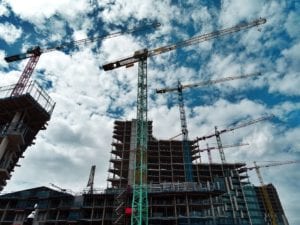South Africa’s construction sector is a key contributor to GDP and jobs, employing around 8% of the South African workforce. With South African unemployment at a record high and broader economic growth constrained, the fortunes of the construction sector have an impact far beyond the sector itself.
*By Johan Gouws and Mohau Mphomela In 2022, there is reason to be cautiously optimistic about the sector’s growth, particularly if stakeholders continue working smarter to optimise opportunities and control costs. A challenging phase The past two years have been challenging for all sectors – particularly construction. In 2020, we saw a 6.4% decline in economic activity as a result of the hard lockdown in Q2 2020, when tourism, hospitality and construction were the sectors hardest hit. As part of an ongoing trend, last year we again saw gross fixed capital formation continuing to decline. This is important because a big part of fixed investments affect the construction sector. In addition, from a macro perspective, the government is still battling with getting fiscal consolidation under control, which is one reason we are not yet seeing significant infrastructure investment from government’s side. There remains general concern about South Africa from both foreign and local investors, who are questioning the wisdom of committing to projects while the country continues to grapple with political infighting, corruption and policy uncertainty. Adding to the challenges of the past two years, electricity supply remained a concern and supply chain disruptions caused the cost of materials to increase. As a result, both order books and margins were negatively impacted. The year ahead After a 6.4% decline and with the easing of lockdown restrictions, the construction sector is set to bounce back by 5.2% this year, but this was off a low base and the expectation is that growth expectations in the next three to five years will be broadly in line with the country’s economic growth projections of around 1.2% to 1.7% per annum. In the year ahead, the government remains hamstrung from a fiscal perspective as debt is still a concern, with expectations that the budget deficit will become less of a concern only by 2024/5. Electricity stability and power supply is expected to remain a constraint on economic activity, and the impacts of the pandemic are an unknown, particularly due to South Africa’s relatively low vaccination rate.There have been some good news, including the South African Infrastructure Investment Plan of close to R3 trillion, followed by the R1.1 trillion Economic Reconstruction and Recovery Plan, both of which could deliver opportunities for construction in future.
However, it should be noted that plans such as these depend on financing. Every year projects are allocated; however without confirmed financing they are just wishes that will not grow the economy or improve the unemployment rate. Without financing, the plans will not materialise, and contractors can only benefit from financed projects that require building. In this regard policy certainty from government is key in building the necessary confidence from potential local and international investors. And while the South African government is battling to contain and reduce national debt and is limited in skills and capacity to deliver on its plans and invest in infrastructure; the National Treasury’s second draft amendments to Regulation 28 of the Pension Funds Act could pave the way for retirement funds – the biggest holders of savings in South Africa – to invest in infrastructure. The latest draft expands the definition of what infrastructure is to include private equity investments, which potentially will release more resources for infrastructure spend and this could then filter through to the construction sector. Opportunities for recovery In 2022, the sector should not expect the rate of recovery we saw in the past few months, but there is some light at the end of the tunnel. In the short term, repair work for the destruction caused during the July riots should boost activity for the construction sector in 2022. There are still good opportunities in urban residential estates, with work from home creating even more opportunities for construction companies. Those who were able to survive the past year or two have the potential to flourish if they stick to their niches, work smarter, and control costs through measures like extending the life of their equipment. As politicians get their act together, there will be less concern around corruption, and the confidence of investors will return. Supply chain disruptions and material costs will also start improving, allowing stakeholders to open their margins again. It is unlikely that the Covid-19 pandemic and current constraints will last forever, and the outlook for the construction sector does not rest entirely on external circumstances. With good leadership and adaptability, construction companies that are able to seize opportunities and work smarter – looking to new materials and technologies to support cost control and efficiencies – will recover. *Johan Gouws is Head of Advice at Sasfin Wealth. He advises MBA North on investments, and Mohau Mphomela is MD at MBA North About the Master Builders Association North The Master Builders Association North is the amalgamation of the former Master Builders Associations of Johannesburg (founded in 1894) and Pretoria (founded in 1903). The organisations merged to form the Gauteng Master Builders Association in 1996, and was renamed Master Builders Association North, representing four regions: Gauteng, North West, Mpumalanga and Limpopo. It is a chapter of the Master Builders Association South Africa. Based in Halfway House, the Master Builders Association North represents the interests of employers in the building and allied trade industries in the abovementioned four regions. It aims to serve its members by facilitating best practice within its membership and the building industry as a whole.







